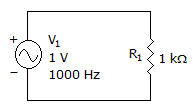Discussion
Home ‣ Electronics ‣ Alternating Current vs Direct Current Comments
- Question
The current is flowing in what direction?

Options- A. clockwise
- B. counterclockwise
- C. in both directions at the same time
- D. 50% of the time clockwise and 50% of the time counterclockwise
- Correct Answer
- 50% of the time clockwise and 50% of the time counterclockwise
- 1. What is the waveform period difference between the 60 Hz electricity used in this country and the 50 Hz used in Europe?
Options- A. 3 ms
- B. 16 ms
- C. 4 ms
- D. 20 ms Discuss
- 2. A sine wave has:
Options- A. four quadrants
- B. two alternations
- C. one period
- D. all of the above Discuss
- 3. Temperature sensing can be achieved by the use of
Options- A. thermocouples
- B. RTDs
- C. thermistors
- D. All of the above Discuss
- 4. The connections to a thermocouple
Options- A. can produce an unwanted thermocouple effect, which must be compensated for
- B. produce an extra desirable thermocouple effect
- C. must be protected, since high voltages are present
- D. produce an extra desirable thermocouple effect and must be protected, since high voltages are present Discuss
- 5. The output voltage of a typical thermocouple is
Options- A. less than 100 mV
- B. greater than 1 V
- C. Thermocouples vary resistance, not voltage.
- D. None of the above Discuss
- 6. What are the two main applications for ac?
Options- A. direct, pulsating
- B. electric, magnetic
- C. power, information
- D. static, dynamic Discuss
- 7. The phase difference between sine waves of different frequencies is:
Options- A. equal to their frequency differences
- B. the difference in their fixed time displacement
- C. the same throughout time
- D. constantly changing Discuss
- 8. Test equipment selection enables the technician to both generate signals and:
Options- A. change circuit conditions
- B. inject signals
- C. sense circuit conditions
- D. change signal frequencies Discuss
- 9. What is the rms voltage value of an ac signal whose peak oscilloscope display uses 3 major divisions above the zero setting? (V/cm = 5)
Options- A. 5.3 V
- B. 10.6 V
- C. 15.0 V
- D. 21.2 V Discuss
- 10. Signal comparisons may be most easily seen when using which item of test equipment?
Options- A. spectrum analyzer
- B. multimeter
- C. function generator
- D. dual trace oscilloscope Discuss
Alternating Current vs Direct Current problems
Search Results
Correct Answer: 3 ms
Correct Answer: all of the above
Correct Answer: All of the above
Correct Answer: can produce an unwanted thermocouple effect, which must be compensated for
Correct Answer: less than 100 mV
Correct Answer: power, information
Correct Answer: the difference in their fixed time displacement
Correct Answer: sense circuit conditions
Correct Answer: 10.6 V
Correct Answer: dual trace oscilloscope
Comments
There are no comments.More in Electronics:
Programming
Copyright ©CuriousTab. All rights reserved.
